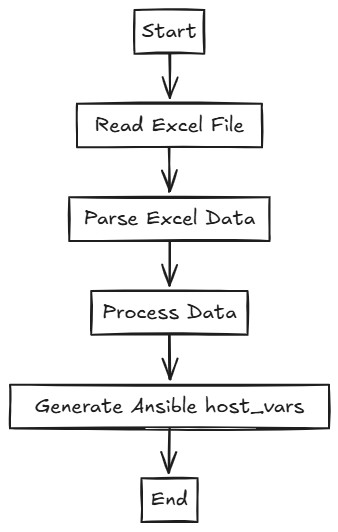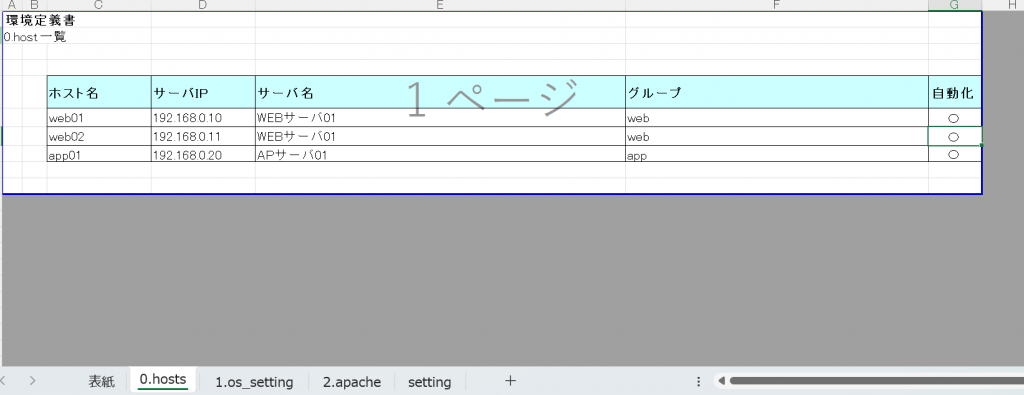Table of Contents
- 1 Introduction
- 2 Prerequisites
- 3 Steps to Creating an Ansible variable file from an Excel
- 3.1 Step 1: 0.hosts sheet setup
- 3.2 Step 2: Setting value sheet setup
- 3.2.1 Pattern 1: List of objects with the same properties
- 3.2.2 Pattern 2: List of dictionaries
- 3.2.3 Pattern 3: A list of dictionaries. Each dictionary has a key called name and a key called para_list. para_list is a list of strings.
- 3.2.4 Pattern 4: Similar to pattern 3, but the parameter name is blank.
- 3.3 Step 3: Execute the Script to Create an Ansible Variable File from Excel
- 4 Conclusion
Introduction
Creating an Ansible variable File from an Excel. In the world of infrastructure as code (IaC), Ansible stands out as a powerful tool for provisioning and managing infrastructure resources. Managing variables for your Ansible scripts can become challenging, especially when dealing with a large number of variables or when collaborating with others.
This blog post will guide you through the process of creating an Ansible variable file from an Excel spreadsheet using Python. By automating this process, you can streamline your infrastructure management workflow and improve collaboration.

Prerequisites
Before we begin, make sure you have the following installed:
- Python: Download and install Python.
- Pandas and openpyxl library: Install it using
pip3 install packename.
Clone the Ansible Excel Tool repository from GitHub:
git clone https://github.com/dangnhuhieu/ansible-excel-tool.git
cd ansible-excel-tool
Steps to Creating an Ansible variable file from an Excel
- Step 1: 0.hosts sheet setup
- Step 2: Setting value sheet setup
- Step 3: Execute the Script to Create an Ansible variable File from Excel
Step 1: 0.hosts sheet setup
Start by organizing your hosts in an Excel spreadsheet.
| column | explain |
| ホスト名 | The hostname of server will create an ansible variable file |
| サーバIP | The hostname of the server will create an ansible variable file |
| サーバ名 | The name of the server will create an ansible variable file |
| グループ | group name of the server will create an ansible variable file |
| 自動化 | The hostname of the server will create an ansible variable file |

The created inventory file will look like this

Step 2: Setting value sheet setup
| column | explain |
| パラメータ名 | name of parameter |
| H~J | setting the value of object server |
| 自動化 | create the variable file or not |
| 変数名 | ansible variable name |
Four variable name patterns are created as examples.
Pattern 1: List of objects with the same properties
Example: The list of OS users for RHEL is as follows.

The web01.yml host_vars variables that are generated are as follows
os_users:
- username: apache
userid: 10010
groupname: apache
groupid: 10010
password: apache
homedir: /home/apache
shell: /sbin/nologin
- username: apache2
userid: 10011
groupname: apache
groupid: 10010
password: apache
homedir: /home/apache2
shell: /sbin/nologinOne way to use the host_vars variable
- name: Create user
user: <br />
name: "{{ item.username }}"
uid: "{{ item.userid }}"
group: "{{ item.groupname }}"
state: present
loop: "{{ os_users }}"Pattern 2: List of dictionaries
Example: RHEL kernel parameters

The host_vars variables created are: para_list is a list of dictionaries, each of which contains a key and value pair.
lst_dic:
- name: os_kernel
para_list:
- key: net.ipv4.ip_local_port_range
value: 32768 64999
- key: kernel.hung_task_warnings
value: 10000000
- key: net.ipv4.tcp_tw_recycle
value: 0
- key: net.core.somaxconn
value: 511One way to use the host_vars variable
- name: debug list kernel parameters
debug:
msg="{{ item.key }} = {{ item.value }}"
with_items: "{{ lst_dic | selectattr('name', 'equalto', 'os_kernel') | map(attribute='para_list') | flatten }}"Pattern 3: A list of dictionaries. Each dictionary has a key called name and a key called para_list. para_list is a list of strings.
Example: < Directory /> tag settings in httpd.conf

The web01.yml host_vars variables that are generated are as follows
lst_lst_httpd_conf_b:
- name: <Directory />
para_list:
- AllowOverride None
- Require all denied
- Options FollowSymLinksOne way to use the host_vars variable
- name: debug lst_lst_httpd_conf_b
debug:
msg:
- "{{ item.0.name }}"
- "{{ item.1 }}"
loop: "{{ lst_lst_httpd_conf_b|subelements('para_list') }}"
loop_control: <br />
label: "{{ item.0.name }}"Pattern 4: Similar to pattern 3, but the parameter name is blank.
Example: Include settings in httpd.conf

The web01.yml host_vars variables that are generated are as follows
lst_lst_httpd_conf_a:
- name: Include
para_list:
- conf.modules.d/00-base.conf
- conf.modules.d/00-mpm.conf
- conf.modules.d/00-systemd.conf
- name: IncludeOptional
para_list:
- conf.d/autoindex.conf
- conf.d/welcome.confOne way to use the host_vars variable
- name: debug lst_lst_httpd_conf_a
debug:
msg:
- "{{ item.0.name }}"
- "{{ item.1 }}"
loop: "{{ lst_lst_httpd_conf_a|subelements('para_list') }}"
loop_control:
label: "{{ item.0.name }}"Step 3: Execute the Script to Create an Ansible Variable File from Excel
python .\ansible\Ansible_Playbook\excel\main.py httpd_parameter_sheet.xlsxOutput

The inventory and host_vars files will be generated as follows

The web01.yml file contents are as follows
os_users:
- username: apache
userid: 10010
groupname: apache
groupid: 10010
password: apache
homedir: /home/apache
shell: /sbin/nologin
- username: apache2
userid: 10011
groupname: apache
groupid: 10010
password: apache
homedir: /home/apache2
shell: /sbin/nologin
lst_dic:
- name: os_kernel
para_list:
- key: net.ipv4.ip_local_port_range
value: 32768 64999
- key: kernel.hung_task_warnings
value: 10000000
- key: net.ipv4.tcp_tw_recycle
value: 0
- key: net.core.somaxconn
value: 511
- name: httpd_setting
para_list:
- key: LimitNOFILE
value: 65536
- key: LimitNPROC
value: 8192
- name: httpd_conf
para_list:
- key: KeepAlive
value: 'Off'
- key: ServerLimit
value: 20
- key: ThreadLimit
value: 50
- key: StartServers
value: 20
- key: MaxRequestWorkers
value: 1000
- key: MinSpareThreads
value: 1000
- key: MaxSpareThreads
value: 1000
- key: ThreadsPerChild
value: 50
- key: MaxConnectionsPerChild
value: 0
- key: User
value: apache
- key: Group
value: apache
- key: ServerAdmin
value: root@localhost
- key: ServerName
value: web01:80
- key: ErrorLog
value: logs/error_log
- key: LogLevel
value: warn
- key: CustomLog
value: logs/access_log combined
- key: LogFormat
value: '"%h %l %u %t \"%r\" %>s %b \"%{Referer}i\" \"%{User-Agent}i\" %D" combined'
- key: Listen
value: 80
- key: ListenBackLog
value: 511
- key: ServerTokens
value: ProductOnly
- key: ServerSignature
value: 'Off'
- key: TraceEnable
value: 'Off'
lst_lst_httpd_conf_a:
- name: Include
para_list:
- conf.modules.d/00-base.conf
- conf.modules.d/00-mpm.conf
- conf.modules.d/00-systemd.conf
- name: IncludeOptional
para_list:
- conf.d/autoindex.conf
- conf.d/welcome.conf
lst_lst_httpd_conf_b:
- name: <Directory />
para_list:
- AllowOverride None
- Require all denied
- Options FollowSymLinks
- name: <Directory /var/www/html>
para_list:
- Require all granted
Conclusion
By following these steps, you’ve automated the process of creating an Ansible variable file from Excel. This not only saves time but also enhances collaboration by providing a standardized way to manage and document your Ansible variables.
Feel free to customize the script based on your specific needs and scale it for more complex variable structures. Thank you for reading the DevopsRoles page!


